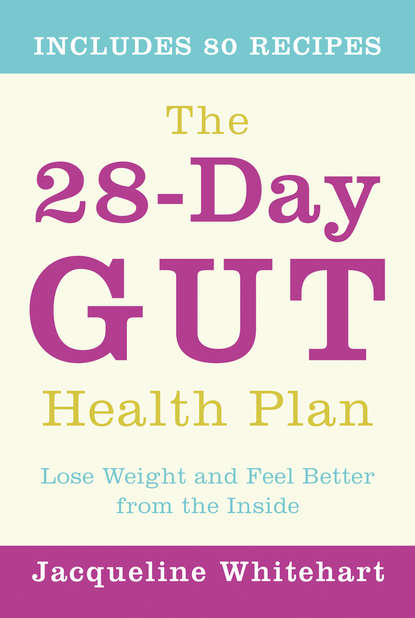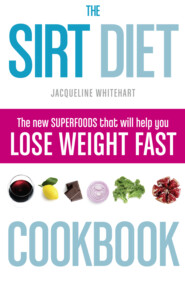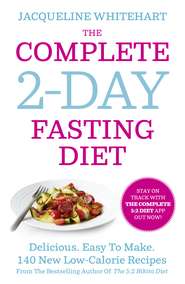По всем вопросам обращайтесь на: info@litportal.ru
(©) 2003-2024.
✖
The 28-Day Gut Health Plan: Lose weight and feel better from the inside
Автор
Год написания книги
2018
Настройки чтения
Размер шрифта
Высота строк
Поля
The symptoms of an unhealthy gut include bloating, gas, cramps, food sensitivities and aches and pains.
If these symptoms affect your daily life severely, this is classed as a medical problem and people are often diagnosed by their doctors as suffering from IBS. But the majority of us haven’t reached that level. We’re struggling on, just managing, and yet slowly the symptoms become more frequent and gut health becomes more of a worry.
The plan aims to reduce your symptoms and helps you learn what foods you should avoid, what foods you can have in moderation and the foods of which you can eat as much as you like.
The symptoms we are hoping to address are:
1.Stomach cramps
2.Bloating and swelling of your stomach
3.Diarrhoea
4.Constipation
5.Excessive Wind
THE PATH TO IBS
The five symptoms – stomach cramps, bloating, diarrhoea, constipation and excessive wind – that are classed as gut-health symptoms are also the symptoms of IBS. Whether you have IBS or not is simply a matter of severity. There is no test that you pass or fail for IBS; it is just a question of how your symptoms affect your daily life. If you get severe stomach cramps overnight then this means that you don’t sleep well and your whole life is affected. This would be IBS. But occasional symptoms are annoying and we tend to just pick ourselves up and get on with it. The trouble is, year on year, your symptoms will slowly and almost imperceptibly get worse. You learn to manage them better, not complaining and just carrying on.
‘Whatever stage you are at, this programme aims to reduce your symptoms by a significant and measurable amount.’
The easiest way to discover more about the health of your gut is to use the Initial Gut Assessment Quiz (see here (#u48714acb-6c8e-5d40-87d7-9a49443dad84)). This gives you a gut-health score on a scale of 1 to 10 and helps you to answer the question: ‘How bad is it?’ If you want to see the progress in your gut health during the programme you can take the quiz again at the end of the plan and see by how much your score has reduced.
The aim of this plan is to reduce your symptoms and hopefully get rid of some of them entirely. You will gain a deeper understanding of your body and its sensitivities, so you are less likely to trigger them. If you find foods that you are sensitive to, don’t worry too much as you will be able to eat them in moderation later on. Just in smaller quantities and less frequently.
DO YOU HAVE A ‘LEAKY GUT’?
What is a leaky gut?
A leaky gut affects the whole body. It’s caused by sections of the gut, normally joints or bends, becoming more porous and developing holes. Food molecules can leach through these holes and enter the bloodstream. The food toxins in your bloodstream set off your natural alarm system. A few undigested food molecules don’t cause a huge problem – your liver is called into action to deal with the toxins. But if the gut is very porous, the liver is quickly overrun and then these foreign bodies absorb into tissues throughout the body, causing them to inflame.
What causes a leaky gut?
Inflammation in the gut lining causes the microvilli filters that act as the barrier between our gut and our bloodstream to be swallowed up. The microvilli are like very fine hairs that protect the delicate gut wall from bigger undigested food molecules. If part of the microvilli are aggravated and inflamed, then those food molecules can get through the lining and become a toxin in the bloodstream.
This can be caused by:
A.Diet: refined sugars, processed foods, preservatives and refined flours. Too many toxins in the gut over many years means that the gut becomes inflamed as it just can’t keep up.
B.Stress: stress almost always results in a suppressed immune system. A weakened immune system cannot handle doing its normal job and gets overrun more quickly, causing inflammation.
C.Bad bacteria: if the bacterial balance in your gut is wrong, the ‘bad’ bacteria can take over and lead to inflammation.
How do you know if you have a leaky gut?
Instead of or as well as gut-health problems (stomach cramps, bloating, diarrhoea) you may get:
Multiple food sensitivities
Frequent colds and illnesses
Skin complaints such as eczema and rashes
Headaches, brain fog and fatigue
THE BOTTOM LINE
Your gut-health problems, aches and pains and food intolerances could all be intrinsically linked. Let’s start at the root of the problem, your gut, and see if we can understand it better. If we understand it and acquire the tools to fix it, then we can control and reduce the other symptoms too.
This 28-day plan is just the start. If you’ve been eating processed foods, refined flours and excessive sugar for twenty, thirty or forty plus years, then we can’t fix the gut in one go. But we can take some huge, positive steps in the right direction and get you feeling better right now.
HOW TO IMPROVE YOUR GUT HEALTH (#ulink_1d47068d-598f-5504-aed7-ccab7127f61b)
The 28-Day Gut-Health Plan is unique in its aim to dramatically improve the state of your gut in just 28 days. How does it do this? There are three practical and effective ways in which we tackle the health of your gut.
3 STEPS TO BETTER GUT HEALTH
1. Resting your gut
‘Like a detox but with food.’
The Gut-Health Plan is not about starving yourself and eating less food. You will eat less, but this will be because of changes in your gut that will result in a reduction in cravings and choosing foods which will keep you fuller for longer. For the first week of the plan, called the Rest and Restore phase, you will remove the five most common trigger foods for a sensitive digestion. These foods are harder for your body to digest, so stay in your gut for longer, causing problems along the way.
The foods that you will eat in the Rest and Restore phase may seem quite restrictive, but you will notice an improvement relatively quickly. Essentially, by sticking to easily digested foods for at least a week, your digestive system doesn’t need to work anywhere near as hard. It’s a relaxing time for your digestion and it will reduce digestive stress. If the gut is not constantly working to digest food, it starts to recover and rebuild. This is a simple yet crucial part in the jigsaw of good gut health.
2. Reducing inflammation
Certain foods can cause the gut wall to react in a negative way. It can make the gut lining swollen, inflamed and extra sensitive. Now, the food triggers that cause inflammation are different for each person. But if we cut out ALL the common triggers during the Rest and Restore phase, then your gut lining has the best chance of getting back to normal. The gut cannot heal when it is inflamed.
3. Introducing good bacteria
The third crucial phase is to improve the balance of bacteria in our gut. We do this more quickly by adding probiotics to our diet for the duration of the programme. Of course, following the programme and reducing processed foods and wheat will slowly improve the bacterial balance anyway, but we are going to give it a helping hand. The best probiotics contain several different strains of bacteria as well as a high concentration of them. Improving bacterial balance means that the food you eat is better digested, which is important for gut health.
THE POWER OF GOOD BACTERIA
Your gut is chock-full of bacteria, good and bad. We can supplement our diet with probiotics (good bacteria) to help reverse the damage caused by years of junk-food overload. Probiotics are found naturally in some foods, particularly yogurt. But to really have an impact on our digestive systems, a probiotic supplement is the best way to ensure we have enough good bacteria to balance the gut effectively.
The good bacteria in a probiotic supplement will:
Aid the digestion of complex foods and/or foods which you cannot currently digest
Compete for space and nutrition with harmful bacteria, reducing their numbers and reducing stomach complaints
Prevent toxins moving from the gut into the blood
Unfortunately, the popular probiotic drinks and enhanced foods don’t really cut the mustard when it comes to supplementing. To get any real benefit, you need a probiotic tablet or powder. The number of different bacterial strains, together with the concentration of bacteria, is most important for success.









